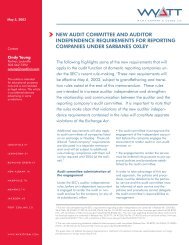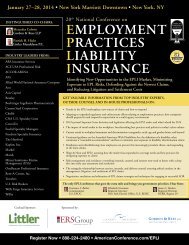Estate Planning in a Low Interest Rate Environment – Grantor ...
Estate Planning in a Low Interest Rate Environment – Grantor ...
Estate Planning in a Low Interest Rate Environment – Grantor ...
You also want an ePaper? Increase the reach of your titles
YUMPU automatically turns print PDFs into web optimized ePapers that Google loves.
4. <strong>Grantor</strong> Trust Status. For <strong>in</strong>come tax purposes, the GRAT is a “grantor trust,” mean<strong>in</strong>g<br />
that trust <strong>in</strong>come is taxed to the grantor rather than the trust. This is an added benefit<br />
from an estate tax perspective, because the grantor’s payment of <strong>in</strong>come taxes on assets<br />
that benefit family members is essentially a tax-free gift to the family members. The<br />
payment of taxes by the grantor rather than the trust can have a substantial positive<br />
impact over time.<br />
5. Selection of Trustee. As with any trust, selection of the trustee is important. The grantor<br />
may serve as trustee dur<strong>in</strong>g the annuity term, but it is very important that the trustee<br />
selected comply with the GRAT provisions and requirements, such as mak<strong>in</strong>g annuity<br />
payments on time. The grantor cannot be trustee after the annuity term, so careful<br />
thought should be given to the selection of a successor trustee.<br />
Downsides<br />
What happens if the GRAT is not successful? If the GRAT assets do not generate<br />
sufficient total return to leave assets rema<strong>in</strong><strong>in</strong>g <strong>in</strong> the trust at the end of the annuity term, then the<br />
GRAT “fails,” mean<strong>in</strong>g that all assets <strong>in</strong> the GRAT are returned to the grantor and no assets have<br />
passed to the grantor’s beneficiaries. However, with the exception of the costs <strong>in</strong>curred <strong>in</strong><br />
sett<strong>in</strong>g up and adm<strong>in</strong>ister<strong>in</strong>g the GRAT, which are m<strong>in</strong>imal compared to the potential sav<strong>in</strong>gs,<br />
there is no downside. Because of this, it is often most beneficial to use short-term or “roll<strong>in</strong>g”<br />
GRATs (at least two years) and “try aga<strong>in</strong>” if the GRAT is not successful at the end of the term.<br />
This may be particularly true for speculative or volatile assets, such as pre-IPO stock.<br />
Because assets <strong>in</strong> the trust are not <strong>in</strong>cluded <strong>in</strong> the grantor’s estate if he survives the trust<br />
term, there is no step-up <strong>in</strong> the basis of the trust assets upon the grantor’s death. This reduces the<br />
sav<strong>in</strong>gs from a GRAT, but with the substantial disparity <strong>in</strong> estate tax rates (45%) versus longterm<br />
capital ga<strong>in</strong>s rate of (15%), the partial offset does not elim<strong>in</strong>ate the advantages of GRAT<br />
plann<strong>in</strong>g.<br />
Installment Sales To An Intentionally Defective <strong>Grantor</strong> Trust<br />
An alternative to a GRAT is an <strong>in</strong>stallment sale to an IDGT. This technique works as<br />
follows:<br />
1. The grantor establishes an irrevocable trust.<br />
2. The trust <strong>in</strong>cludes provisions caus<strong>in</strong>g it to be treated as a “grantor trust” for <strong>in</strong>come tax<br />
purposes, mean<strong>in</strong>g that all trust <strong>in</strong>come is taxed to the grantor. 6 Such a trust is often<br />
referred to as be<strong>in</strong>g “<strong>in</strong>tentionally defective”.<br />
3. The grantor “seeds” the trust with a small gift (usually at least ten percent (10%) of the<br />
value of the property <strong>in</strong> the trust after the sale).<br />
6 There are several ways to make a trust a grantor trust for <strong>in</strong>come tax purposes, however, this discussion is outside<br />
the scope of this article. See Code §671 et seq.











